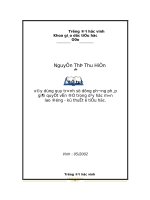Thuyết Trình Môn Critical Reading Problem Solving Đọc Phân Tích Giải Quyết Vấn Đề.pptx
Bạn đang xem bản rút gọn của tài liệu. Xem và tải ngay bản đầy đủ của tài liệu tại đây (1.25 MB, 42 trang )
Critical reading
Problem solving
L/O/G/O
Group 8
1. Nguyễn Quỳnh Anh
2. Nguyễn Thị Lan Anh
3. Nguyễn Thị Huyền
4. Nguyễn Thị Kiều Mai
5. Đỗ Thị Mười
6. Đỗ Thị Phương Thảo
7. Nguyễn Phương Thảo
Contents
What do you mean a “problem”
1
2
How do we solve problems?
3
Selecting and using information
4
Processing data:
5
Recognising pattern
6
7
Hypotheses, reasons, explanations and
inference
Necessity and sufficiency
Problem ?
Problem
Function:
Achieve the task may need considerable thought and planning
Systematic or involve trial and error
Three clearly defined :
1. Identifying which pieces of data are relevant when faced with a
mass of data, most of which is irrelevant
2. Combining pieces of information that may not appear to be related
to give new information
3. Relating one set of information to another in a different form – this
involves using experience: relating new problems to ones we have
previously solved
Phương Thảo
Problem
Summary:
1. Look at what a problem is and how the word can be used in
different ways.
2. See how information is used to contribute to the solution of
a problem.
3. Look at how various methods of using information can lead
to effective solutions
Phương Thảo
How do we solve problems?
Problem
information
question
Quỳnh Anh
How do we solve problems?
Data
Proces
s
Solutio
n
Quỳnh Anh
How do we solve problems?
Ways to solve
‘heuristic’
method
systematic
method
Quỳnh Anh
How do we solve problems?
‘heuristic’
method
systematic
method
Quỳnh Anh
How do we solve problems?
Frist
involves thinking carefully about when you last
came into the house and what you did
Second
involves searching every room of the house
thoroughly until they are found
Quỳnh Anh
Selecting and using information
• Problem solving involves understanding and making use of
information
• The problem to solve is to select the correct pieces of
information and to use them in an appropriate manner.
•
Information can come in 5 main forms.
Nguyễn Phương Thảo
Selecting and using
information
5 forms that sets of information can take:
Tables: these could include summaries of surveys, specification sheets
or transport timetables.
Graphs: these are used in science and business to provide
information in such a way that it can be absorbed quickly and easily.
For example, a graph may show variables such as temperature over
time; financial data may be shown in bar charts.
Words: numerical, spatial, logical and many other types of
information can be summarised or described in words.
Pictorial: pictures, for example in the form of engineers’ or
architects’ drawings, can be used not only to show what something
looks like, but also to give information about relative sizes and
positions.
Diagrammatic: diagrams come in a wide range of forms: flow charts,
maps, schedules, decision trees and many other types can summarise
numerical and spatial information.
Nguyễn Phương Thảo
Selecting and using
information
Practice
The pie charts illustrate the change that the introduction of the
CD in 1985 had on the recorded-music market. Total annual
sales of all types of recording in 1984 were 170 million and in
1994 they were 234 million.
Nguyễn Phương Thảo
Selecting and using
information
* What, approximately, happened to the actual annual sales of
vinyl singles between 1984 and 1994?
•
•
•
•
•
A. They fell by 14 million.
B. They fell by 5 million.
C. They were unchanged.
D. They rose by 17 million.
E. They rose by 64 million.
Nguyễn Phương Thảo
Selecting and using
information
Commentary:
In 1984, vinyl single sales were 44% of 170 million, or 74.8
million; in 1994, they were 26% of 234 million, or 60.8 million.
=> So A is correct – they fell by 14 million
Nguyễn Phương Thảo
Selecting and using
information
Summary
• In this part, we have seen how data can be presented in
several different forms.
• We have also seen the importance of reading the
question carefully to ensure that the correct pieces of
data are extracted from the information given and used
correctly.
Nguyễn Phương Thảo
Processing Data
Processing Data
Finding methods of solution
Solving problems by searching
Huyền
Processing Data
1.Finding methods of solution:
• The way of proceeding to an answer in some problems may
not be clear:
- either because it is necessary to find an intermediate solution
first,
- or because we need to work simultaneously forward from the
data and backwards from the required answer.
Huyền
Processing Data
• One strategy that can help to solve problems when you are not
clear how to proceed is to analyze the problem:
- organize the information.
- write down or underline those pieces of information which are
important.
- simplify.
- look at the question and decide what pieces of information
could lead to the answer .
- make a sketch, list or table.
Huyền









